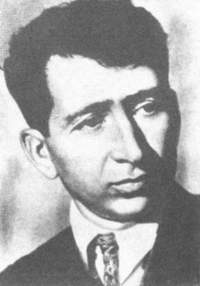- Yeghishe Charents
Infobox Writer
name = Yeghishe Charents
Եղիշե Չարենց

imagesize = 150px
caption = Noted Armenian poet Yeghishe Charents.
birthdate = March 13, 1897
birthplace = Kars,Kars Oblast ,Russian Empire
deathdate = death date and age|1937|11|29|1897|3|13
deathplace =Yerevan ,Soviet Armenia
occupation =Poet ,writer , public activist
Yeghishe Charents (Lang-hy|Եղիշե Աբգարի Չարենց;
March 13 ,1897 –November 29 ,1937 ) was an Armenianpoet and public activist. Charents was one of the most outstanding poets of the twentieth century, touching upon a multitude of topics that ranged from his experiences in theFirst World War ,socialism , and, more prominently, onArmenia and Armenians.hy icon Aghababyan, S. "«Չարենց, Եղիշե Աբգարի»" (Charents, Yeghishe Abgari).Soviet Armenian Encyclopedia . vol. viii. Yerevan, Armenian SSR:Armenian Academy of Sciences , 1982, pp. 670-672.]An early champion of
communism , Charents joined theBolshevik party , but as the Soviet state clamped down on nationalism in the 1930s, he gradually grew disillusioned withStalinism and was later executed during the 1930spurges .Biography
Early life
Yeghishe Charents was born Yeghishe Soghomonyan in Kars, then a part of the Russian Empire, in 1897 to a family involved in the
rug trade. He first attended an Armenian, but later transferred to a Russian, technical secondary school in Kars from 1908 to 1912. In 1912, he had his first poem published in the Armenian periodical "Patani". [cite book
last = Hacikyan
first = Agop J
coauthors= Gabriel Basmajian, Edward S. Franchuk
title = The Heritage of Armenian Literature, Vol. 3: From The Eighteenth Century To Modern Times, vol. 3
publisher = Wayne State University Press
location = Detroit
year = 2005
pages = p. 959
isbn = 0-8143-3221-8] Amid the upheavals of theFirst World War and theArmenian Genocide in theOttoman Empire , he volunteered to fight in a detachment in 1915 for the Caucasian Front. Sent toVan in 1915, Charents was witness to the destruction that the Turkish garrison had laid upon the Armenian population, leaving indelible memories that would later be read in his poems. He left the front one year later, attending school at the Shanyavski People's University inMoscow . The horrors of the war and genocide had scarred Charents and he became a fervent supporter of theBolsheviks , seeing them as the one true hope to saving Armenia.Arnavoudian, Eddie. " [http://groong.usc.edu/tcc/tcc-20050711.html Yeghishe Charents: Poet of Life as Permanent Revolution, Pt. 2] ." The Critical Corner.July 11 ,2005 . RetrievedSeptember 15 ,2008 .] [Hacikyan et al. "Heritage of Armenian Literature", p. 959.]Charents joined the
Red Army and fought during theRussian Civil War as a rank and file soldier in Russia and the Caucasus. In 1919, he returned to Armenia and took part in revolutionary activities there. A year later, he began work at the Ministry of Education as the director of the Art Department. Charents would also once again take up arms, this time against his fellow Armenians, as a rebellion took place against Soviet rule in February 1921.Poet
Some of Charents' experiences would later appear in his poetry.
He had two daughters Arpenik and Anahit.
Death
A victim of Stalinism, he died in prison. He was rehabilitated in 1954 after Stalin's death.
Legacy
His works were translated by
Valeri Bryusov ,Anna Akhmatova ,Boris Pasternak ,Louis Aragon and others.His home at No. 17 Mashtots Avenue in Yerevan was turned into a museum in 1975. The Armenian city
Charentsavan was named after him.Works
His last collection of poems, "The Book of The Way", was printed in 1933, but its distribution was delayed by the Soviet government until 1934, when it was reissued with some revisions. In this book the authors lays out the panorama of Armenian history and reviews it part-by-part.
Charents was also translated many works into Armenian, such as the "
The Internationale ."*"Three songs to the sad and pale girl...", poems (1914)
*"Blue-eyed Homeland", poem (1915)
*"Soma", poem (1918)
*"Charents-Name", poem (1922)
*"Uncle Lenin", poem (1924)
*"Country of Nairi" ("Yerkir Nairi") (1926)
*"Epical Sunrise", poems (1930)
*"Book of the Way", poems (1933-34)Notes
Additional reading
*cite book
last = Nichanian
first = Marc
coauthors = Vartan Matiossian, Vardan Matteosean
title = Yeghishe Charents: Poet of the Revolution
publisher = Mazda Publishers
date = 2003
isbn = 1-5685-9112-8ee also
*
Armenian Genocide External links
* [http://www.umd.umich.edu/dept/armenian/literatu/charents.html Yeghishe Charents, biography, by Shant Norashkharian]
* [http://charents.lastak.net/Epigramner/index.html Charents Armenian site]
* [http://groong.usc.edu/tcc/tcc-20050711.html Yeghishe Charents, By Eddie Arnavoudian, Groong.Com]
Wikimedia Foundation. 2010.
